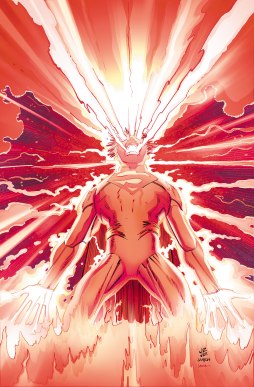 When the going gets tough, the tough read uplifting poetry.
When the going gets tough, the tough read uplifting poetry.
“Hope” is the thing with feathers –
That perches in the soul –
And sings the tune without the words –
And never stops – at all –And sweetest – in the Gale – is heard –
And sore must be the storm –
That could abash the little Bird
That kept so many warm –I’ve heard it in the chillest land –
And on the strangest Sea –
Yet – never – in Extremity,
It asked a crumb – of Me.
Stay tuned for the poem in Dickinson’s own handwriting.
Super Powers

This lovely, comforting poem uses the extended metaphor of a bird to show the power of hope. The way it is set up also gives me the mental image of a beam of superhuman strength bursting out of me.
In the first stanza, “Hope” is presented as a small bird that is always singing within our souls. The first stanza takes place within this space. If we follow the traditional conception of the soul as something inside us, we see that the second stanza moves the bird outwards from the soul into the open air. In the third stanza, a separate person “I” is introduced, who can hear the bird and observe it as a separate entity, which lead me to assume that their bird no longer (solely) lives within them.
As our perspective shifts, the world around the bird becomes increasingly violent and dangerous: we move from a storm to a cold land and a strange sea. The speaker even literally calls it ‘Extremity’. The more savage the world becomes, the more we see of the power of “Hope” until we reach its ultimate strength: it always gives itself freely. Now, tell me that doesn’t sound like a super power. (Or perhaps I’ve just seen too many Marvel movies recently.)
What I love most about the poem is that “Hope” is presented as extremely powerful, but also as something small and delicate: a little singing bird. Rather than being as harsh as the storms, the bird brings forth beauty (sweet sounding bird song), and lovingness (“that kept so many warm”) to combat the outside world. For me, the poem advocates using love and inner strength to keep going instead of opting for violence. (Very unlike those DC/ Marvel super heroes, I could mention.)

As it seems silly to talk about Emily Dickinson without saying at least something about her style, I’ll end with two notes on the appearance of the poem on the page:
Frequent Use of Dashes
The first thing that catches your eye when looking at the poem is its use of dashes. Some editors remove these for readability, but it is more often seen as an expression of Dickinson’s unique style. Dickinson is known for freeing herself from the restrictive literary conventions of her time and experimenting with imagery and expression. The dashes fragment the language and draw together seemingly unrelated words, thus playing with the emphasis in the poem as well as giving it a musical flow.
A Lack of Title
Emily Dickinson’s poems do not give a title, so we commonly use the first line as its title. The poems are also often numbered, but unlike, for example, Shakespeare’s sonnets Dickinson’s poems do not have the same number in every edition so we cannot use them without creating even more confusion.
***
Many of Emily Dickinson’s poem manuscripts and even drafts survived. Of some poems we have several versions, because she sent them to friends, wrote them up neatly after a messy draft etc. Not all of these manuscripts are the same, so occasionally editors have to choose which version they want to include. I haven’t been able to trace a draft (trust me, this is not what those look like) or alternate version of this poem, so if you happen to know more about it, let me know! Fortunately, we do have the poem written out in her own handwriting, which I think is very special as well.

Let’s chat!
What does this poem mean to you? Do you find the dashes helpful or annoying? Have you read any other poems by Emily Dickinson?
I like the dashes, they seem to act a bit like commas in some places, indicating where to draw breath. I wonder why they’re on the end of some lines and nott others though..
LikeLiked by 1 person
Excellent pick – but what I like even more reading this right now is how you describe this with wit, intelligence and an engaging flow of words/sentences (not unlike Emily). Thank you for sharing your thoughts so eloquently 🙂
LikeLiked by 1 person
Ohhh thanks! I feel so flattered 😀
LikeLike